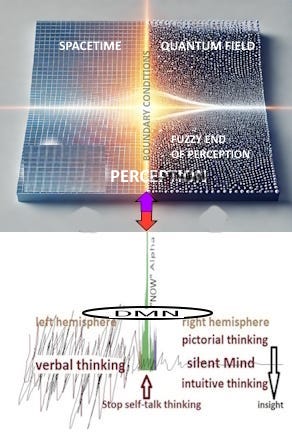
The search for enlightenment has often been seen as a spiritual pursuit, a movement beyond the noise of ordinary life into a state of clarity and unity. But what if this process could be understood as a transformation within the brain and mind themselves? What if enlightenment is not a metaphysical attainment, but a natural evolution of our cognitive structure? At the heart of this evolution is what can be called the extended brain-mind, a process that reaches its culmination in a state of awareness known as thought-being. This state, positioned at what we might call the boundary condition of cognition, allows for a fundamental shift in how we experience knowing.
The extended brain-mind is not a theoretical model, but a lived experience. It begins when the fragmented activity of verbal thinking begins to dissolve, and a new pattern of inner coherence takes shape. Instead of processing the world in parts, the mind begins to sense the whole. Pictorial thinking, intuition, imagination, and silence all begin to interact — not competitively, but coherently. This is not merely a deeper form of thinking. It is a preparation for the disappearance of the separate thinker. As this extended mind matures, it doesn’t seek to accumulate more thoughts, but to enter a state where thought and being are no longer separate.
This convergence is what gives rise to thought-being. It is not thought in the traditional sense, because it does not operate through verbal or linear processing. And it is not being in the passive sense, because it is aware and alert. Rather, it is a state in which awareness is so coherent, so still, that it resonates with a greater field of intelligence. In this state, thinking is not self-generated, but tuned to something deeper. There is no strain to know. Knowing arises from within, as a natural property of being fully present.
This is what we can call boundary condition brain-mind thinking. It is the threshold between the personal mind and the universal mind. It does not occur through effort, but through alignment. In this state, the mind is not reaching outward; it is opening inward, into the field where intuition, silence, and direct perception become one. This is the real doorway to enlightenment. Not a mystical escape, but a tangible shift in how the brain-mind functions when it has come to rest within itself.
Many who enter this state report a subtle capacity to sense the future — not as a prediction, but as a resonance. The future is no longer a projection. It is something already forming in the field of awareness. This is not a gift, but a consequence of coherence. When the mind is free from internal conflict, it becomes sensitive to the larger order unfolding around it. That sensitivity is thought-being. That stillness is the interface.
In this sense, enlightenment is not a light that descends from above. It is a structure that forms from within. It is the extended brain-mind finding its home in the boundary condition, where being and knowing meet. And once this state is stabilised, life continues — but now, it is lived from the centre, not the edge. From silence, not noise. From coherence, not confusion. This is the responsibility and the freedom of thought-being: to live with the universe, rather than within the chaos of the separate self.

